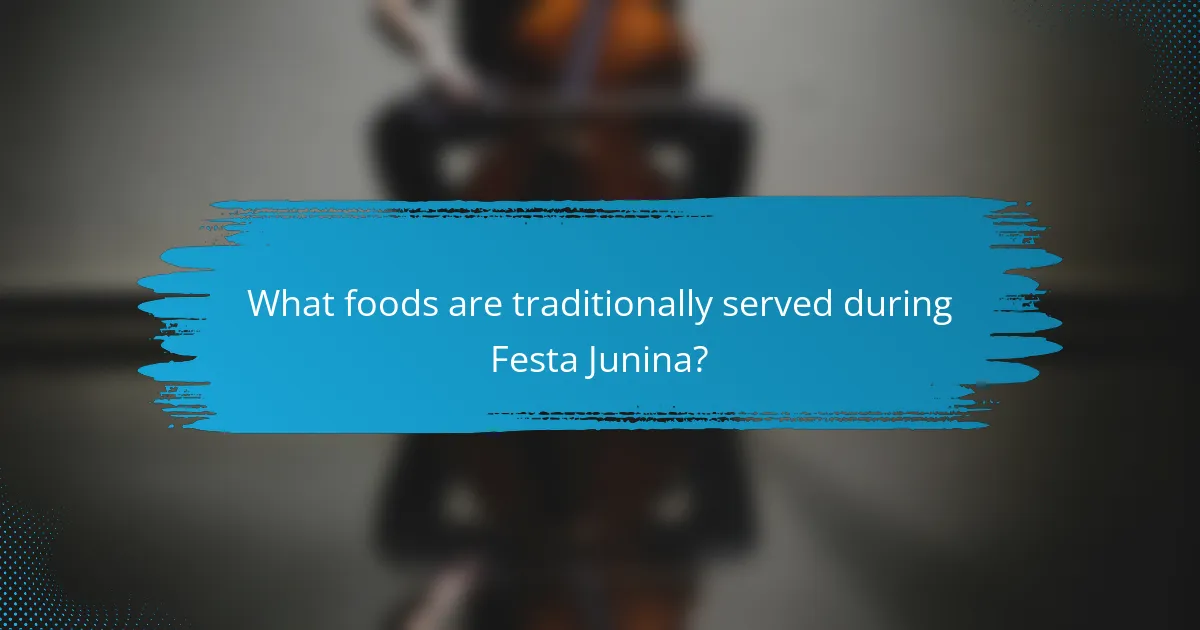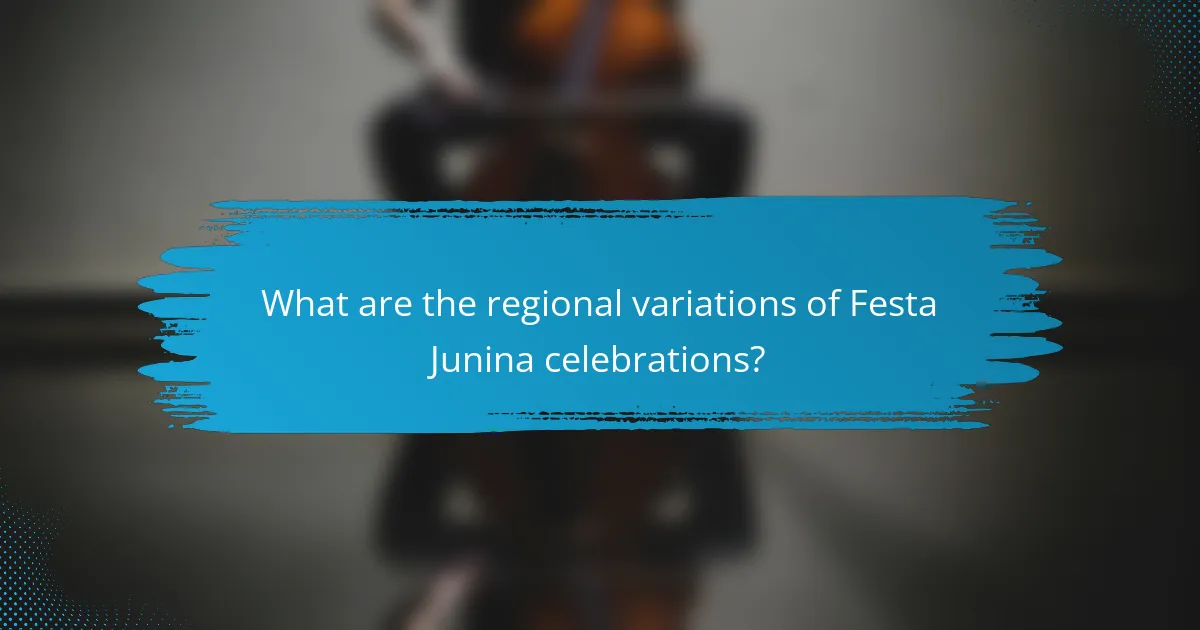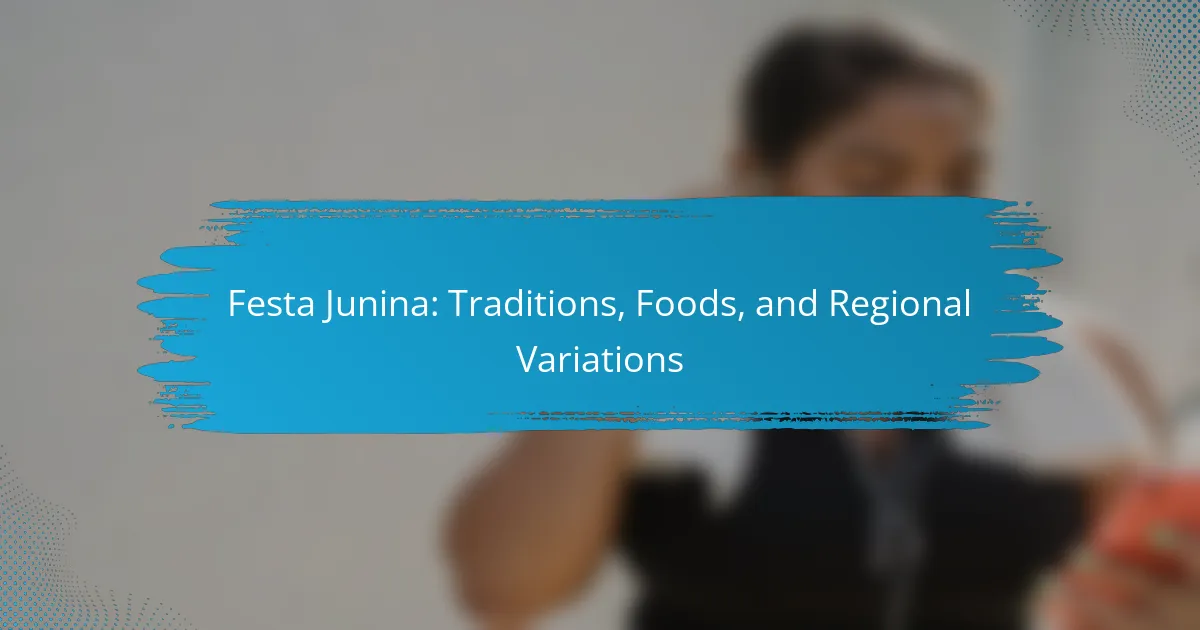Festa Junina is a traditional Brazilian festival celebrated in June, honoring rural life and the harvest season. The festival features vibrant activities such as bonfires, folk dancing known as quadrilha, and a variety of traditional foods, including milho verde (grilled corn), pamonha (corn pudding), and canjica (sweet corn porridge). Celebrations vary across Brazil’s regions, with distinct customs and dishes reflecting local cultural heritage. The Northeast emphasizes lively dances and corn-based foods, while the Southeast incorporates urban elements like fireworks, and the South highlights gaucho culture. Each region’s unique approach to Festa Junina fosters community spirit and showcases the festival’s agricultural roots.

What is Festa Junina?
Festa Junina is a traditional Brazilian festival celebrated in June. It honors rural life and the harvest season. The festival features bonfires, dancing, and traditional foods. Common activities include quadrilha, a folk dance, and games. Popular foods served during the festival include milho verde (green corn), pamonha, and canjica. Festa Junina has roots in European midsummer celebrations. It is widely celebrated across Brazil, with regional variations in customs and dishes. The festival attracts large crowds and fosters community spirit.
How did Festa Junina originate?
Festa Junina originated from European harvest festivals, particularly those celebrated in France and Portugal. These festivals were brought to Brazil by Portuguese colonizers in the 16th century. Over time, they merged with local indigenous and African traditions. This fusion created a unique celebration that honors Saint John, among other saints. The event typically occurs in June, aligning with the harvest season in Brazil. Traditional elements include bonfires, folk dances, and typical foods like corn dishes. The celebration reflects the rural lifestyle and agricultural significance in Brazilian culture. Historical records indicate that the modern form of Festa Junina began to take shape in the 19th century.
What historical events influenced the development of Festa Junina?
Festa Junina developed from various historical events, particularly the influence of European harvest festivals. These festivals celebrated the summer solstice and included elements like bonfires and traditional foods. Additionally, the arrival of Portuguese colonizers in Brazil introduced their own cultural practices. The blending of Indigenous and African traditions also shaped the festival’s unique characteristics. Key historical events, such as the agricultural calendar and the Catholic celebration of St. John, further influenced the festival’s timing and customs. This fusion of cultural influences created the vibrant celebration known today as Festa Junina.
What cultural elements are integral to Festa Junina’s origins?
Festa Junina’s origins are deeply rooted in Brazilian rural culture. The celebration is linked to the harvest season, particularly the corn harvest. Traditional elements include folk music, such as forró and quadrilha dances. These dances mimic rural life and courtship rituals. Costumes often reflect country attire, with checkered patterns and straw hats. Foods like corn-based dishes and sweets are central to the festivities. The event also incorporates religious elements, honoring Saint John, a key figure in the celebration. Overall, Festa Junina blends agricultural practices with cultural expressions of community and faith.
What are the key traditions associated with Festa Junina?
Key traditions associated with Festa Junina include bonfires, traditional dances, and folk games. Bonfires symbolize warmth and harvest celebrations. Traditional dances, such as quadrilha, involve couples performing choreographed moves. Folk games include activities like “festa do pau de sebo” and “corrida de sacos.” These traditions reflect rural life and community spirit. Participants often wear traditional attire resembling rural costumes. The festival also features typical foods like corn-based dishes and sweets. These elements create a festive atmosphere celebrating the June harvest in Brazil.
How do these traditions vary across different regions?
Festa Junina traditions vary significantly across different regions of Brazil. In the Northeast, the celebration features vibrant costumes, traditional dances like quadrilha, and regional foods such as corn dishes and sweets. In contrast, the Southeast incorporates more urban elements, with parties often held in schools and community centers, emphasizing music and dance performances. The South showcases a blend of European influences, leading to the inclusion of different foods and customs. Each region’s unique cultural background influences the specific rituals, music styles, and culinary offerings associated with Festa Junina. For example, the Northeast’s strong agricultural roots result in a focus on corn-based foods, while the South may highlight barbecue and wine.
What roles do music and dance play in Festa Junina celebrations?
Music and dance are central to Festa Junina celebrations. They create a festive atmosphere and foster community engagement. Traditional music, such as forró and xote, accompanies the dances. These musical styles reflect the rural roots of Brazilian culture. Dancers often wear colorful costumes, enhancing the visual appeal of the event. The quadrilha is a popular group dance performed during the festivities. It involves choreographed movements and storytelling elements. Overall, music and dance are vital for cultural expression and celebration during Festa Junina.

What foods are traditionally served during Festa Junina?
Traditional foods served during Festa Junina include corn-based dishes, sweets, and savory snacks. Popular items are pamonha, a corn pudding wrapped in corn husks. Another favorite is canjica, a sweet corn porridge made with milk and sugar. People also enjoy milho verde, or grilled corn on the cob. Additionally, there are savory options like sausage and meat skewers. Sweet treats include pé de moleque, a peanut brittle, and bolo de milho, a corn cake. These foods reflect the agricultural roots of the festival, celebrating the harvest season.
What are the most popular dishes at Festa Junina?
The most popular dishes at Festa Junina include pamonha, canjica, and milho verde. Pamonha is a corn-based dish made from fresh corn and often served with cheese. Canjica is a sweet dish made from hominy corn, milk, sugar, and cinnamon. Milho verde refers to grilled corn on the cob, typically served with butter and salt. Other favorites include quentão, a hot spiced drink made from cachaça, and bolo de milho, a corn cake. These dishes are traditional and widely enjoyed during the festivities, reflecting regional culinary practices in Brazil.
How are these dishes prepared and served?
Festa Junina dishes are typically prepared using traditional methods that reflect regional ingredients. Common preparations include boiling, frying, and baking. For example, corn is often boiled to make pamonha, while canjica is made by cooking corn with milk and sugar. Dishes like bolo de milho are baked using a mixture of cornmeal, eggs, and milk.
These dishes are usually served in a communal style, often on large tables covered with checkered cloths. Guests typically enjoy the food in a festive atmosphere, accompanied by music and dance. Traditional serving methods enhance the cultural experience of Festa Junina, allowing participants to share and celebrate together.
What ingredients are essential for Festa Junina foods?
Essential ingredients for Festa Junina foods include corn, peanuts, and sweet potatoes. Corn is used to make dishes like pamonha and canjica. Peanuts are often found in sweets and snacks, adding flavor and texture. Sweet potatoes are commonly roasted or used in desserts. Other ingredients include coconut, milk, and sugar, which enhance the sweetness of traditional treats. These ingredients reflect the agricultural roots of the festival, celebrating the harvest season.
How do regional variations affect the food served during Festa Junina?
Regional variations significantly influence the food served during Festa Junina. Each region of Brazil showcases unique ingredients and culinary traditions. For instance, in the Northeast, dishes like canjica and pamonha are popular. These foods reflect local agricultural practices and available crops. In contrast, the South features foods such as quentão and pinhão, highlighting regional climate and harvests. Additionally, cultural influences from indigenous, African, and European communities shape the flavors and preparation methods. This diversity creates a rich tapestry of food experiences during the festival, celebrating local identity and heritage.
What unique dishes are found in different Brazilian states?
Brazilian states feature unique dishes that reflect regional cultures. In Bahia, the dish Acarajé is popular, made from black-eyed peas and filled with shrimp. Minas Gerais is known for its Pão de Queijo, a cheese bread that is a staple snack. In São Paulo, the Virado à Paulista is a traditional dish consisting of rice, beans, sausage, and pork. The state of Rio de Janeiro offers Feijoada, a black bean stew with various meats. In the North, particularly in Pará, Tacacá is a dish made with jambu, shrimp, and tucupi. Each of these dishes showcases the diverse culinary heritage of Brazil and is often featured during Festa Junina celebrations.
How do local ingredients influence Festa Junina cuisine?
Local ingredients significantly influence Festa Junina cuisine by shaping its flavors and dishes. Each region in Brazil incorporates its native produce, leading to diverse culinary expressions. For example, in the Northeast, corn is a staple, featured in dishes like pamonha and canjica. In contrast, the Southeast might emphasize ingredients like peanuts and sweet potatoes. Seasonal availability of local crops also dictates menu items during the festival. This reliance on regional ingredients fosters a connection to local culture and traditions. Furthermore, the use of local flavors enhances the authenticity of the dishes served at Festa Junina celebrations.

What are the regional variations of Festa Junina celebrations?
Festa Junina celebrations vary significantly across different regions of Brazil. In the Northeast, festivities are marked by lively quadrilha dances and traditional foods like corn dishes. The Southeast incorporates more urban elements, featuring fireworks and concerts. In the South, the emphasis is on gaucho culture, with traditional music and chimarrão served. Each region showcases unique local customs and foods, reflecting their cultural heritage. For example, in São João, Pernambuco, the celebration lasts the entire month of June with elaborate decorations and street parties. In contrast, São Paulo’s celebrations are more commercialized, often held in large venues.
How do celebrations differ in the Northeast compared to other regions?
Celebrations in the Northeast, particularly Festa Junina, emphasize traditional rural customs and folk culture. This region showcases vibrant costumes, lively dances, and specific foods like corn dishes and sweets. In contrast, other regions may focus on different cultural influences and modern festivities. For example, the Southeast often incorporates urban celebrations with influences from international cultures. The Northeast’s emphasis on community and traditional practices is distinct. Historical roots in agriculture shape the Northeast’s festive atmosphere. Celebrations here often include bonfires and regional music, which differ from the more commercialized events in other areas.
What specific customs are unique to Northeastern Festa Junina?
Northeastern Festa Junina features unique customs such as the “quadrilha,” a traditional folk dance. Participants dress in rural costumes, reflecting the region’s agrarian culture. The “quadrilha” is characterized by choreographed movements and storytelling through dance. Another custom is the “pula-pula,” a festive bonfire that symbolizes the celebration of Saint John. Traditional foods like “canjica,” made from corn, and “pamonha,” a corn-based dish, are also integral to the festivities. Additionally, “fogueira,” or bonfire lighting, is a significant ritual, believed to ward off evil spirits. These customs highlight the cultural richness of Northeastern Brazil during the Festa Junina.
How do climate and geography influence regional celebrations?
Climate and geography significantly influence regional celebrations by shaping the timing, themes, and activities involved. For instance, in Brazil, Festa Junina occurs during the dry season, which aligns with the harvest of crops like corn. This celebration features traditional foods such as corn dishes, reflecting the agricultural practices of the region. Additionally, geographic factors determine the types of festivities held. In northeastern Brazil, for example, the arid climate leads to a focus on rural traditions and folk dances. In contrast, regions with more temperate climates may incorporate different elements into their celebrations. Historical patterns show that local climate conditions directly impact the availability of resources used in these festivities, reinforcing the connection between environment and cultural practices.
What are some lesser-known regional practices during Festa Junina?
Lesser-known regional practices during Festa Junina include the “Fogueira de São João” in the Northeast, where large bonfires are lit to symbolize purification. In some areas, people participate in “Pula Fogueira,” a traditional game where participants jump over the bonfire for good luck. In Minas Gerais, “Quadrilha” dance is often performed with unique local costumes and themes. Additionally, certain regions incorporate “Bandeirinhas,” colorful flags that decorate streets and homes, creating a festive atmosphere. These practices highlight the cultural diversity of Festa Junina across Brazil, showcasing local customs and traditions.
How do local communities put their own spin on traditional festivities?
Local communities put their own spin on traditional festivities by incorporating unique regional elements. For example, in Festa Junina, different states in Brazil showcase distinct foods, music, and dances. In the Northeast, communities emphasize traditional dances like the quadrilha. In the South, variations may include local delicacies such as pinhão. Additionally, some regions blend modern influences with traditional practices, creating new interpretations. These adaptations reflect local culture, history, and available resources. This diversity enhances the festive experience and fosters community identity.
What impact do these variations have on the overall experience of Festa Junina?
Variations in Festa Junina significantly enhance the overall experience. They introduce diverse cultural expressions and local traditions. Each region showcases unique foods, dances, and decorations. This diversity fosters a richer atmosphere for participants. For instance, Northeastern Brazil emphasizes traditional music and dance, while Southern regions may focus on different culinary offerings. Such differences create a sense of community and belonging among attendees. Additionally, regional variations attract a wider audience. They encourage participation from individuals with different cultural backgrounds. This inclusivity contributes to a vibrant and dynamic celebration. Overall, these variations play a crucial role in shaping the festive experience.
What tips can enhance the Festa Junina experience?
To enhance the Festa Junina experience, engage in traditional activities and embrace the festive spirit. Participate in games like the “pescaria,” which is a popular fishing game. Enjoy traditional foods such as “pamonha” and “canjica,” which are staples of the celebration. Dress in typical attire, including checkered shirts and straw hats, to immerse yourself in the culture. Attend local events to experience regional variations in festivities. Decorate your space with colorful banners and lanterns to create a festive atmosphere. Joining in dance, especially the quadrilha, adds to the enjoyment. These activities contribute to a richer and more authentic Festa Junina experience.
Festa Junina is a traditional Brazilian festival celebrated in June, honoring rural life and the harvest season through activities such as bonfires, folk dances like quadrilha, and a variety of regional foods. The festival has roots in European midsummer celebrations and features unique customs that vary across Brazil’s regions, reflecting local culture and agricultural practices. Key foods include corn-based dishes such as pamonha and canjica, while music and dance play a significant role in fostering community spirit. This article explores the origins, key traditions, regional variations, and culinary highlights associated with Festa Junina.
